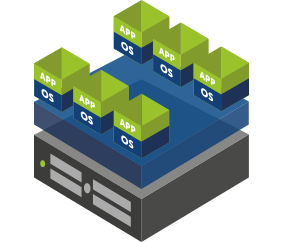Deploying a Virtual Fax Server

Deploying a virtual fax server using Imecom’s Useit Messaging fax server software is a rather simple undertaking. In fact, a virtual fax server consists of the same core fax server software that you would find in a traditional TDM (software/hardware) solution. But the difference of course is that virtual fax server deployments don’t require a physical fax card, or any hardware for that matter. So how do you deploy a fax server without a fax card?
Fax Servers Have Evolved
For a long time, network fax server solutions were comprised of fax server software and one or multiple PCI fax boards or modems, installed and run on a physical server. The fax card or modem would accept your analog/POTS lines or your T1/PRI circuit, and the fax application software would tie into corporate email servers, desktop and enterprise applications, an so on. You stick the server in a corner in your server room and off it goes.
While this type of architecture is still available today – and still works just fine – new technologies like voice over IP and server virtualization have quickly made that fax card a thing of the past. Fax over IP (FoIP) and Virtual Fax Servers are now the norm. So let’s take a look at what’s involved with deploying a virtual fax server.
Lose That Fax Board and Go Virtual
The primary limitation with deploying a new virtual fax server or migrating an older fax server to a virtual server platform is that darn fax board. You may find yourself looking at that green circuit board and asking yourself “How do I use this with a virtual server?”. Well, the good news is that you no longer need it. You now have the option of deploying Fax over IP (FoIP) servers and Hybrid Cloud Fax Servers, both of which consist entirely of software and can run on virtual server platforms like VMware, Hyper-V, and Citrix Xen.
Hybrid Fax Solutions
Hybrid Fax Solutions are a combination of premise-based fax server software and cloud fax service infrastructure (IaaS). Useit Hybrid Fax Solutions pair our Useit Fax Server software with etherFAX hosted fax service infrastructure to create a secure HIPAA compliant HTTPS fax solution.
The Useit Hybrid Fax Software can be deployed on a virtual server within your network. No physical fax card or T.38 IP fax driver software is required. Instead, the Useit Hybrid Fax Server will open a secure connection to etherFAX and authenticate using your specific account credentials. Once authenticated, the fax job is encrypted and sent/received via the etherFAX network. This type of configuration is perfect for organizations that want to keep the core fax server architecture on-premise and move the telephony portion of the fax architecture to the cloud.
Fax over IP Solutions
Imecom’s Fax over IP (FoIP) Solutions consist of Useit Fax Server software and IP fax driver software. Useit Fax Server supports two IP fax drivers – XCAPI from TE-Systems and Brooktrout SR140 from Dialogic. The IP Fax Driver software replaces a traditional fax card and thus makes it possible to deploy your fax server on a hypervisor of your choice.
IP fax driver software is in essence a virtual fax card. It has ports or channels like a regular PCI fax card, where each port equates to a simultaneous call. Useit Fax over IP solutions make it possible to transmit and receive traditional T.30 fax audio over IP networks, typically through an IP-PBX or VoIP Gateway, or SIP Trunk(s) from an external carrier. Useit FoIP Solutions typically support two codecs – T.38 and G.711. Let’s take a look at both.
T.38
T.38 is the ITU recommendation for reliable transmission of fax audio over IP networks in real time. T.38 is typically used when a fax server sends a fax over the PSTN through a T.38-enabled fax gateway which converts or encapsulates the T.30 protocol into T.38 data stream. This is then sent either to a T.38 enabled end point such as another T.38-compatible fax server, or another T.38 Gateway that converts the signal back to PSTN PCM or analog and terminates the fax on a T.30 device.
The T.38 recommendation defines the use of both TCP and UDP to transport T.38 packets. A majority of T.38 fax server deployments tend to use UDP, as TCP requires acknowledgement packets and this tends to result in packet loss, which introduces delays and packet re-transmission – all not so good for faxing. UDP, on the other hand, deals with packet loss by using redundant data packets. T.38 is not a call setup protocol, thus the T.38 devices need to use standard call setup protocols to negotiate the T.38 call, e.g. H.323, SIP & MGCP.
G.711
G.711 is an ITU-T recommendation for Pulse Code Modulation (PCM) of voice frequencies. It uses an uncompressed format and requires high bandwidth, typically about 64 kbps. Using G.711 as the transport method for FoIP is an extension of traditional PSTN audio-based faxing. The digital fax data is converted to a PCM audio stream and then sent as G.711 Real-time Transport Protocol (RTP) packets.
G.711 has not been optimized for fax transport over IP networks, and does not typically support packet redundancy. Having been developed for voice, G.711 allows the transmission of missing audio because any gaps would be filled in by a human listener. But when used to transmit modem data, any loss of packets is significant, because the receiver has no way to recreate the missing data.
It is our recommendation to enable T.38 for reliable real-time fax over IP whenever possible.
Fax Server Virtualization Is Simple
Whether you want to deploy an on premise IP fax server and leverage your existing VoIP infrastructure, or you want leverage a Useit Hybrid Fax Solution to securely route faxes via etherFAX, Imecom makes it possible, and simple, to virtualize your fax server architecture.
